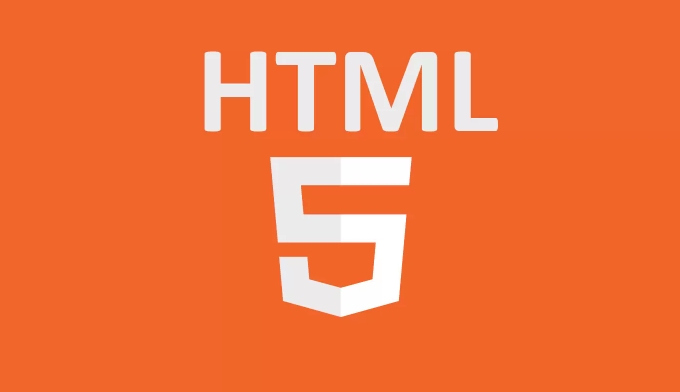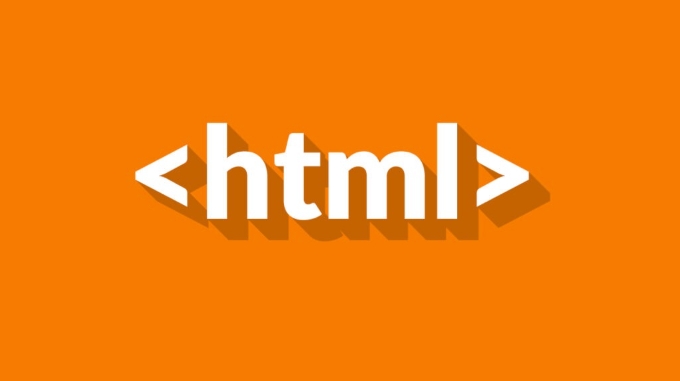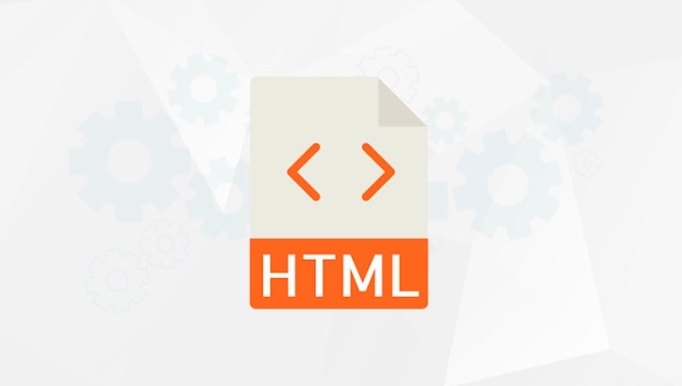What are the essential html attributes for form validation?
Jun 29, 2025 am 01:09 AMHTML provides a variety of built-in properties to implement form validation without JavaScript. First, the required attribute ensures that the field cannot be empty and is suitable for text, email, password and other types; secondly, minlength and maxlength limit the input length, such as passwords need to be between 8 and 20 characters; thirdly, type attributes such as email, url, and number automatically verify the data format, and support min and max to control the numerical range; finally, pattern combines regular expressions to realize custom verification, such as limiting the five-digit zip code, and at the same time, it is necessary to cooperate with title prompts the user format requirements.

When it comes to form validation in HTML, you don't always need JavaScript. There are several built-in attributes that help validate user input right in the browser. These attributes make your forms more reliable and user-friendly without extra coding.

required – Make Fields Mandatory
The required attribute is one of the most commonly used for basic validation. When added to an input field, it ensures the user can't submit the form without filling it out.

For example:
<input type="text" name="username" required>
This tells the browser that the username field must have a value before the form can be submitted. The browser will automatically show an error message if the field is left blank.

Tips:
- Works with most input types like text, email, password, etc.
- Doesn't validate content quality, just present.
minlength / maxlength – Control Input Length
These two attributes are especially useful when you want to limit how short or long a user's input can be. This is helpful for fields like passwords or usernames.
Example:
<input type="password" name="password" minlength="8" maxlength="20">
Here, the password must be at least 8 characters and no longer than 20. If not met, the browser blocks submission and show a default message.
Keep in mind:
- Values ??are character counts.
- Works with text-based inputs like text, password, textarea.
type – Use Correct Input Types
HTML5 introduced several input types that automatically perform basic validation. For example:
-
type="email"checks for a valid email format. -
type="url"makes sure the input is a properly formatted URL. -
type="number"restricts input to numeric values ??only.
Using these types helps ensure users enter the correct kind of data without needing custom scripts.
Examples:
<input type="email" name="user_email"> <input type="number" name="age" min="18" max="99">
Some types also support additional attributes like min , max , and step for more control over acceptable values.
pattern – Custom Validation with Regular Expressions
If you need stricter validation rules (like a specific format for phone numbers or zip codes), the pattern attribute lets you define a regular expression that the input must match.
Example:
<input type="text" name="zipcode" pattern="\d{5}" title="Enter a 5-digit zip code"> In this case, the input must be exactly five digits. If not, the browser will show the message from the title attribute.
Important notes:
- Pattern uses regex, so it can get complex quickly.
- Always pair with a clear
titleto explain expected format.
That's the core set of HTML attributes you'll use for client-side form validation. They're straightforward but powerful enough for many common scenarios. Not too flashy, but definitely essential.
The above is the detailed content of What are the essential html attributes for form validation?. For more information, please follow other related articles on the PHP Chinese website!

Hot AI Tools

Undress AI Tool
Undress images for free

Undresser.AI Undress
AI-powered app for creating realistic nude photos

AI Clothes Remover
Online AI tool for removing clothes from photos.

Clothoff.io
AI clothes remover

Video Face Swap
Swap faces in any video effortlessly with our completely free AI face swap tool!

Hot Article

Hot Tools

Notepad++7.3.1
Easy-to-use and free code editor

SublimeText3 Chinese version
Chinese version, very easy to use

Zend Studio 13.0.1
Powerful PHP integrated development environment

Dreamweaver CS6
Visual web development tools

SublimeText3 Mac version
God-level code editing software (SublimeText3)

Hot Topics
 How do I stay up-to-date with the latest HTML standards and best practices?
Jun 20, 2025 am 08:33 AM
How do I stay up-to-date with the latest HTML standards and best practices?
Jun 20, 2025 am 08:33 AM
The key to keep up with HTML standards and best practices is to do it intentionally rather than follow it blindly. First, follow the summary or update logs of official sources such as WHATWG and W3C, understand new tags (such as) and attributes, and use them as references to solve difficult problems; second, subscribe to trusted web development newsletters and blogs, spend 10-15 minutes a week to browse updates, focus on actual use cases rather than just collecting articles; second, use developer tools and linters such as HTMLHint to optimize the code structure through instant feedback; finally, interact with the developer community, share experiences and learn other people's practical skills, so as to continuously improve HTML skills.
 How do I use the element to represent the main content of a document?
Jun 19, 2025 pm 11:09 PM
How do I use the element to represent the main content of a document?
Jun 19, 2025 pm 11:09 PM
The reason for using tags is to improve the semantic structure and accessibility of web pages, make it easier for screen readers and search engines to understand page content, and allow users to quickly jump to core content. Here are the key points: 1. Each page should contain only one element; 2. It should not include content that is repeated across pages (such as sidebars or footers); 3. It can be used in conjunction with ARIA properties to enhance accessibility. Usually located after and before, it is used to wrap unique page content, such as articles, forms or product details, and should be avoided in, or in; to improve accessibility, aria-labeledby or aria-label can be used to clearly identify parts.
 How do I create a basic HTML document?
Jun 19, 2025 pm 11:01 PM
How do I create a basic HTML document?
Jun 19, 2025 pm 11:01 PM
To create a basic HTML document, you first need to understand its basic structure and write code in a standard format. 1. Use the declaration document type at the beginning; 2. Use the tag to wrap the entire content; 3. Include and two main parts in it, which are used to store metadata such as titles, style sheet links, etc., and include user-visible content such as titles, paragraphs, pictures and links; 4. Save the file in .html format and open the viewing effect in the browser; 5. Then you can gradually add more elements to enrich the page content. Follow these steps to quickly build a basic web page.
 How do I create checkboxes in HTML using the element?
Jun 19, 2025 pm 11:41 PM
How do I create checkboxes in HTML using the element?
Jun 19, 2025 pm 11:41 PM
To create an HTML checkbox, use the type attribute to set the element of the checkbox. 1. The basic structure includes id, name and label tags to ensure that clicking text can switch options; 2. Multiple related check boxes should use the same name but different values, and wrap them with fieldset to improve accessibility; 3. Hide native controls when customizing styles and use CSS to design alternative elements while maintaining the complete functions; 4. Ensure availability, pair labels, support keyboard navigation, and avoid relying on only visual prompts. The above steps can help developers correctly implement checkbox components that have both functional and aesthetics.
 How do I minimize the size of HTML files?
Jun 24, 2025 am 12:53 AM
How do I minimize the size of HTML files?
Jun 24, 2025 am 12:53 AM
To reduce the size of HTML files, you need to clean up redundant code, compress content, and optimize structure. 1. Delete unused tags, comments and extra blanks to reduce volume; 2. Move inline CSS and JavaScript to external files and merge multiple scripts or style blocks; 3. Simplify label syntax without affecting parsing, such as omitting optional closed tags or using short attributes; 4. After cleaning, enable server-side compression technologies such as Gzip or Brotli to further reduce the transmission volume. These steps can significantly improve page loading performance without sacrificing functionality.
 How has HTML evolved over time, and what are the key milestones in its history?
Jun 24, 2025 am 12:54 AM
How has HTML evolved over time, and what are the key milestones in its history?
Jun 24, 2025 am 12:54 AM
HTMLhasevolvedsignificantlysinceitscreationtomeetthegrowingdemandsofwebdevelopersandusers.Initiallyasimplemarkuplanguageforsharingdocuments,ithasundergonemajorupdates,includingHTML2.0,whichintroducedforms;HTML3.x,whichaddedvisualenhancementsandlayout
 How do I use the element to represent the footer of a document or section?
Jun 25, 2025 am 12:57 AM
How do I use the element to represent the footer of a document or section?
Jun 25, 2025 am 12:57 AM
It is a semantic tag used in HTML5 to define the bottom of the page or content block, usually including copyright information, contact information or navigation links; it can be placed at the bottom of the page or nested in, etc. tags as the end of the block; when using it, you should pay attention to avoid repeated abuse and irrelevant content.
 How do I embed video in HTML using the element?
Jun 20, 2025 am 10:09 AM
How do I embed video in HTML using the element?
Jun 20, 2025 am 10:09 AM
To embed videos in HTML, use tags and specify the video source and attributes. 1. Use src attributes or elements to define the video path and format; 2. Add basic attributes such as controls, width, height; 3. To be compatible with different browsers, you can list MP4, WebM, Ogg and other formats; 4. Use controls, autoplay, muted, loop, preload and other attributes to control the playback behavior; 5. Use CSS to realize responsive layout to ensure that it is adapted to different screens. Correct combination of structure and attributes can ensure good display and functional support of the video.






